#marilène oliver
Text


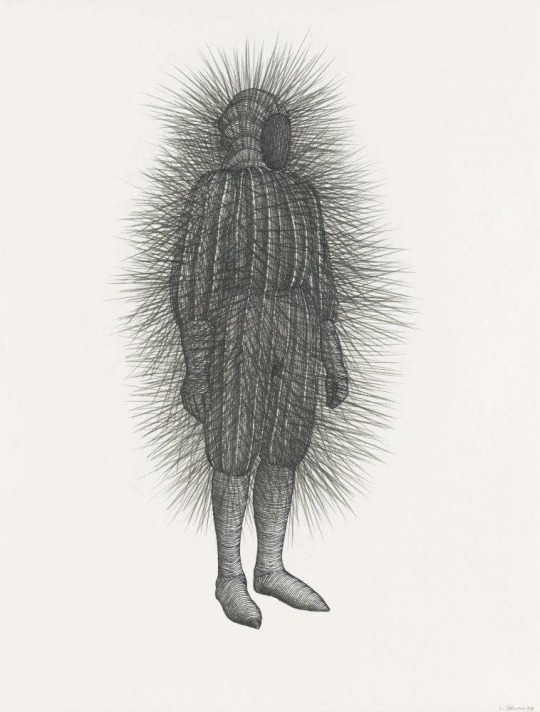
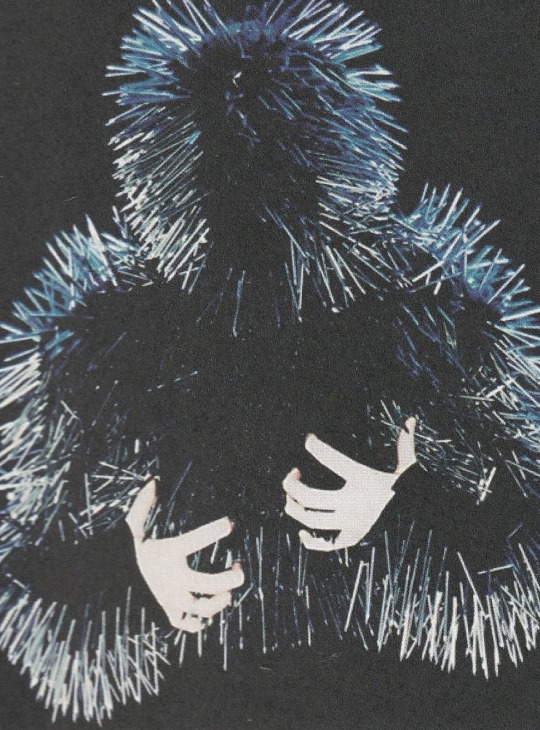
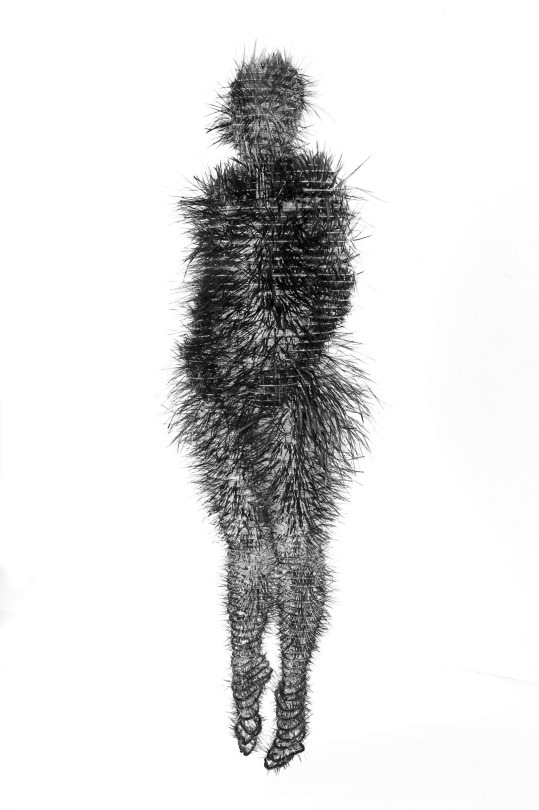

Knife Angel - Alfie Bradley / Matthew Swift / Walter Oltmann / Andrew Groves x / Marliène Oliver / Siberian bear hunting armor 1800s
#knife angel#alfie bradley#andrew groves#matthew swift#walter oltmann#marilène oliver#1800s#19th century#siberia#art#artwork#art work#parallels#comparatives#compilation#marliene oliver#armor#armour
11K notes
·
View notes
Text

Marilène Oliver
Dervishes, 2007
Source
140 notes
·
View notes
Text

On Fire' is laser etched graphite on Somerset paper and the image is made using ray casting rendering from newly commissioned MRI data. "Thematically it explores constantly being alone with yourself (in a digital world) and suggests a craving for human connection."
Marilène Oliver.
.
"On Fire", 2019, Laser etched graphite on Somerset satin,
208 x 76 cm.
2 notes
·
View notes
Text
DATA GAMES
FRAGMENTED MEMORY : 2013
Phillip Davide Stearns

Tapis tissé en coton dont l'image est conçue numériquement à partir de la base de données envoyée depuis l'ordinateur appartenant à l'artiste. Il utilise un programme de récupération de données sur Processing ce qui lui permet de créer une image à partir du Data stocké. L’image est ensuite importée sur Netgraphique (logiciel spécifique au design de textile) afin de créer un patron et définir une palette.
Ce processus tend à brouiller les frontières entre une planche photographique et une visualisation de données et offre une alternative pour stocker de l’information.

Il prend son propre quotidien et sa relation avec le virtuel pour tisser des motifs et les exposer. « Fragmented memory » met en avant une problématique contemporaine sur la conservation des données, leur transmission et leur accessibilité. Comme ce reflexe après avoir renverser du vin sur le parquet pour ensuite le recouvrir d'un vieux tapis. Le problème n'est pas sous mais fait partie du tapis. Nous vivons à travers les réseaux et, en même temps, on désire garder notre vie privée, ce qui est inconciliable. Il a cependant créé un antivirus.
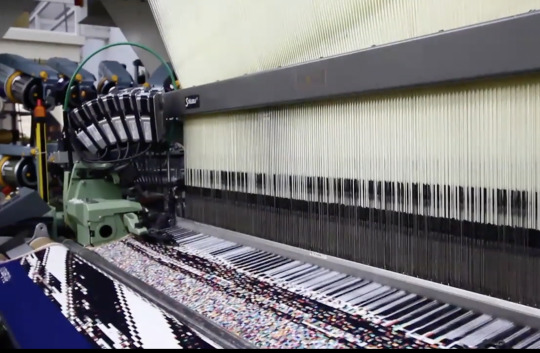
Cette approche fait écho direct avec la manière de communiquer et la transmission visuelle d'information qui pourrait se réaliser avec le textile, à l’instar des quipus dans l’empire inca. Il utilise le visuel et le physique comme médium pour stocker et transmettre une information.
DEEP CONNECTION : 2021
Marilène Olivier

Espace virtuel où l’on observe un corps flottant sur le dos. On peut ainsi se déplacer et explorer son fonctionnement interne grâce à certaines interactions. Des données 4D déferlent rendant le corps comme vivant. Le spectateur peut entendre des battements et une respiration comme une mélodie chantée venant du corps. On se retrouve comme en présence de quelqu’un d’autre. Le matériel VR est stocké dans les trois statues de l’exposition.
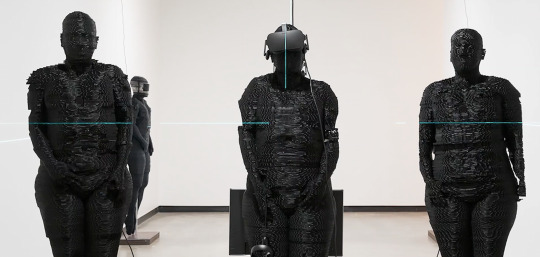
Marilène Oliver a obtenu des données de balayage par résonance magnétique de son corps entier en collaboration avec des chercheurs en radiologie et informatique de l’Université d’Alberta. Ces IRM donnent des images très précises des éléments constitutifs du corps.

Si on part du principe que la manière dont nous nous voyons influe sur notre compréhension de nous-même, en incluant le virtuel, cela crée un flou entre l’immatériel et le vivant dans un espace dont on ne connait que des paramètres prédéfinis. On se retrouve plongé dans une autre réalité à laquelle on veut aussi croire. Cela questionne également notre relation avec les médias virtuels et physiques qui nous affectent à longueur de temps.
SANGRE BOLIVIANA : 1991
Luigia Grosseberg

Elle naît en Bolivie et émigre aux États-Unis à l’âge de trois ans. Lucia Grosseberg ressent le besoin de renouer avec ses origines dont elle ne garde que des sensations. Un jour pendant qu’elle enseigne la lecture dans un lycée elle aperçoit dehors un de ses élève scotcher devant une arcade de jeux des heures durant. Elle reste fascinée, mais aussi frustrée que ses cours ne lui procurent pas le même effet. Cet évènement la pousse à arrêter d’enseigner et ironiquement à s’intéresser aux ordinateurs.

Lors de la sortie des Apple II, elle est impressionnée et s’en procure un en vendant la plupart de ses biens. Elle fait ses débuts dans l’art digital grâce au programme ColorSoft Demo. Le trouvant trop simple, elle crée Designer's Toolkit avec Harry Vertelney et David Rifkin, logiciel également publié par Apple Computer pour qui elle travaillera un temps. C’est chez eux qu’elle apprendra le code et fera son entrée dans la conception d’œuvre interactive.

Son vécu l’a amené à réaliser Sangre Boliviana, soit neuf pièces interactives qui retracent des parties de sa vie. Elle exploite une manière ludique d’interagir avec le spectateur en le plongeant dans un jeu qui explore sa propre vie. C’est sa manière à elle de retenir et d’explorer ses propres informations - comme un journal intime - et d’avoir un lien avec toutes et tous.
MID : Graber Nyria.
8 notes
·
View notes
Text
« Messis » : une expérience virtuelle transcendante

La compagnie Van Grimde Corps Secrets présente Messis , une websérie sur la reconnexion de l’humain à la nature, accompagnée d’une plateforme donnant accès aux coulisses de la création et des réflexions à l’origine de l’œuvre.
Une riche expérience artistique, scientifique, philosophique.
La websérie Messis Après une impressionnante première websérie de danse (Eve 2050 : la websérie ), Van Grimde Corps Secrets dévoile Messis . Ancrée dans une réflexion sur le devenir du corps et de l’humanité, dans le contexte des changements sociaux et technologiques exacerbés ou accélérés par la pandémie, Messis célèbre la reconnexion à la terre et l’exultation du corps physique. Forte d’une esthétique exigeante et poussée, la websérie mêle danse, musique, arts visuels et médiatiques, technologies interactives, design 3D et réalité augmentée.
Pour cette création pour 9 interprètes, Isabelle Van Grimde retrouve trois partenaires créatifs précieux : le compositeur Thom Gossage , le producteur-réalisateur Robert Desroches de DAVAI et l’artiste visuelle et médiatique Marilène Oliver . Les compositions musicales de Thom Gossage, inspirées par les rythmes syncopés du Sacre du printemps de Stravinsky, gardent une identité propre pour répondre à des chorégraphies marquées par une énergie brute, et un mouvement de l’ordre de la transe et du rituel.
0 notes
Photo
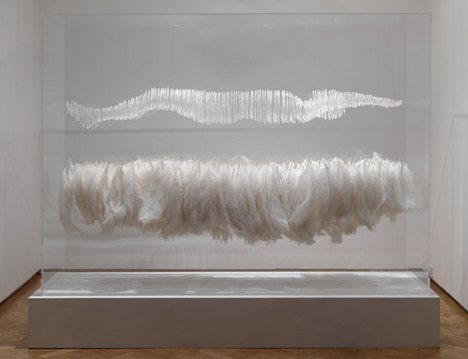
Dreamcatcher, Marilène Oliver, 2009, Laser-cut acrylic, fishing wire and ostrich feathers, 150 x 216 x 50 cm, Ed. 3 On a street called Cork Street in central London there is a window where you can see a very int...
23 notes
·
View notes
Photo



Marilène Oliver - Family Portrait
5 notes
·
View notes
Text
Q & A with Digital Age Artist Marilène Oliver
TEDMED: In your 2018 TEDMED Talk and exhibit, your work depicted a digitized future. What have you learned through the process of creating this work?
Marilène Oliver: I would say that they also depict a digitised present: the majority of my daily life is spent creating and moving packets of data around and the fact that I can now be represented as a high-resolution scan dataset pretty much sums how I understand and know myself! Understanding and questioning how we are digitised – both our physical bodies and our digitized activities – is fascinating for me, as it offers powerful metaphors to think about what and who we are becoming in the digital age. Equally, finding the right processes and materials to creatively re-export and materialise that scan data has been very important. There is no question that transparent materials were best for making my early stacked sculptures, then I needed to work with neon materials so that certain features could be highlighted and tagged. Now I am working with virtual reality: material concerns could disappear completely. Reflecting on the choices that I make in order to create artworks made from scan data teaches me a lot about my relationship to digitisation.
TM: Your work has strong scientific elements in it. Have you always had an interest in science?
MO: My interest in science has grown as my work has developed. I soon realized when I started working with scan data that many of the possibilities of the technology were not available to me (both practically and poetically) as long as I didn’t understand the science behind it. I started by reading as much as I could and trying to teach myself but when I needed more structure and reliable content I applied to do a long distance MSc in Imaging at the University of Edinburgh. This has helped me greatly, not only to understand the actual science of imaging better, but also to understand the rigid structure and pressures of scientific research compared to artistic research, but there is so much I still don’t know and it feels impossible to keep up! I strongly believe in interdisciplinary research and now at the University of Alberta I have been able to bring together a fabulous team of radiologists, computer scientists, digital humanists and nurses. We are currently developing projects that will allow us to create virtual and augmented reality artworks which is very exciting.
TM: In your Talk you discuss the challenges using MRI data posed, such as it being slow to acquire and could not be reformatted, which led you to use CT scans for your muse Melanix. What other challenges did you encounter when creating your work using digitized bodies?
MO: As I explained briefly in my talk, one of the most challenging times for me was moving to Angola and waking up to the fact that Melanix was not only a medical dataset that I needed to think about as a creative resource and material, but also a symbol of first world privilege. Until moving to Angola, I had taken scan data more or less for granted, but working with Melanix in Angola where the majority of the population had little or no access to public healthcare, let alone the possibility to be scanned, caused me to radically rethink my practice and my relationship to data acquired to cure rich white people when there were still countries with endemic malaria and people still die of tetanus poisoning every day. Making art with medical data in Angola demanded I realize my position as a privileged white woman of colonial heritage, which ashamedly I hadn’t considered until that time. This technology and these concerns are far from global and digital privilege is a huge issue that threatens to exacerbate the disgusting inequalities in the world.
The ethics of data anonymization is also something I find problematic. I understand it in medical research, but when it is being used to create artworks, I question whether this is always the ‘right’ solution. I have made scores of artworks using the Melanix dataset yet I have no idea who the original subject of the scan is. I would hope the work I have made would please the original subject if she were to know about it, but as we learn more and more how the digital data we generate is used and abused by government and corporations and other individuals, I think there has to be better discussions and global agreements about the ethics of data ownership.
TM: What are you currently working on? What is your inspiration for this work?
MO: Since my talk, I have made two virtual reality artworks and sculptural installations using a new high-resolution MRI dataset acquired with researchers at the University of Alberta. Deep Connection is the first work we made using virtual reality and was inspired from experiences using the Body VR app which allows 3D medical scan datasets to be loaded into virtual reality space as a semi-transparent block of data.
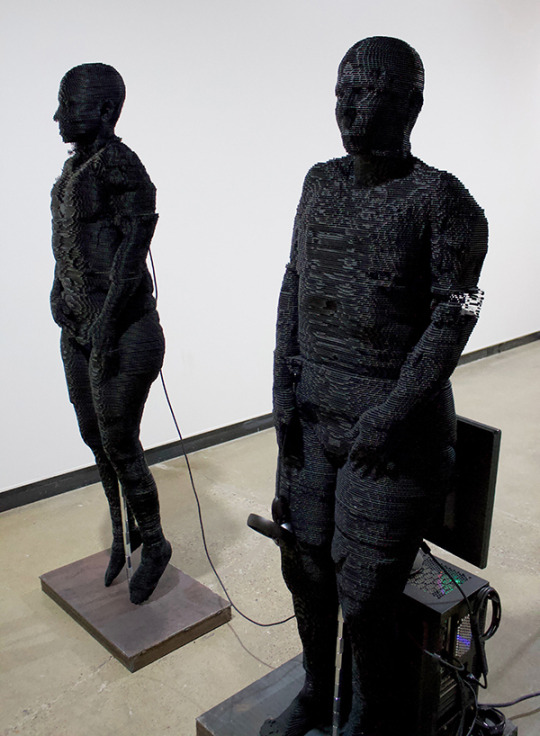
Photo Courtesy of Marilène Oliver-“Deep Connection”
When the viewer enters the Deep Connection, they see a scanned body lying prone in mid-air. The user can walk around the body and inspect it, lie underneath it and walk through it. The user can put their head inside the body: dive inside and see its inner workings, its lungs, spine, brain. Using a virtual hand, they can then take hold of the figure’s outstretched hand, trigger a 4D dataset and see figure’s heart beat and lungs breathe. When the user lets go the hand, the heart stops beating and the lungs stop breathing. Deep Connection has an interactive soundscape made by Gary James Joynes made from recordings of the MRI scanner. When the user holds the figure’s hand a human voice sings a beautiful mourning song. The VR experience is part of a sculptural installation created using the same MRI data. The installation is comprised of a row of 3 sculptures of bodies into which the VR hardware is embedded/housed. The sensors are embedded in the chest of the outer two figures, and the inner figure holds the headset, controller and guards the workstation.
The post Q & A with Digital Age Artist Marilène Oliver appeared first on TEDMED Blog.
Read more from TEDMED https://blog.tedmed.com/q-a-with-digital-age-artist-marilene-oliver/#utm_source=rss&utm_medium=rss
0 notes
Link
This is a link to a 51 minute live performance video on Marilene Oliver’s website which has been a constant source of inspiration to me as she deals with simalar subject matter and identical source material, working from the starting point of CT & MRI scans.
0 notes
Text

Marilène Oliver
Ötzi: Frozen, Scanned & Ploted, 2006
Acrylic and light.
38 notes
·
View notes
Link
I came across this artist in a book about modern scultpure in the library. Unfortunately there was only a two page feature of Ms. Oliver’s work that was inspired by the same initial area of investigation as mine; Scans.
Luckily I came across this website which is just littered with beautiful 3D work in much the same vein as my digital work or at least using the same source material as a starting point.
I intend to write my essay on a piece of work by her.
0 notes